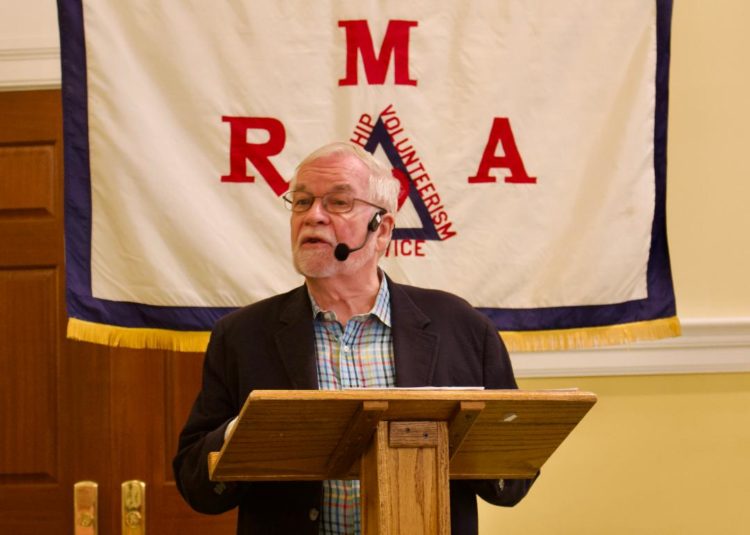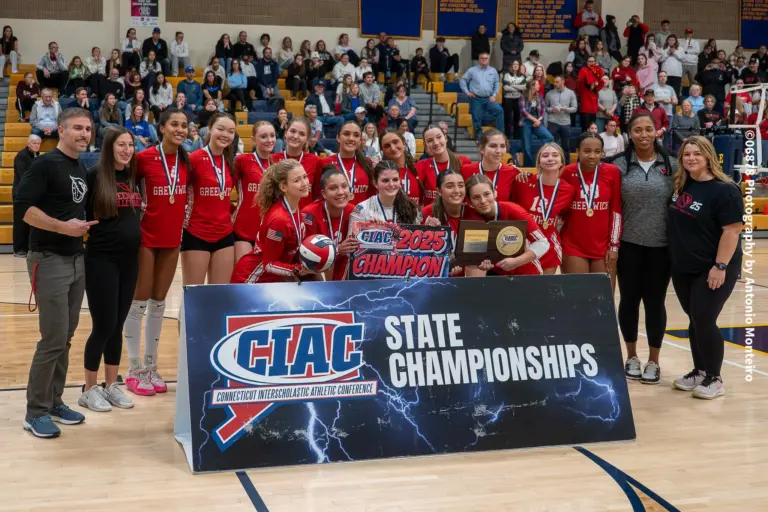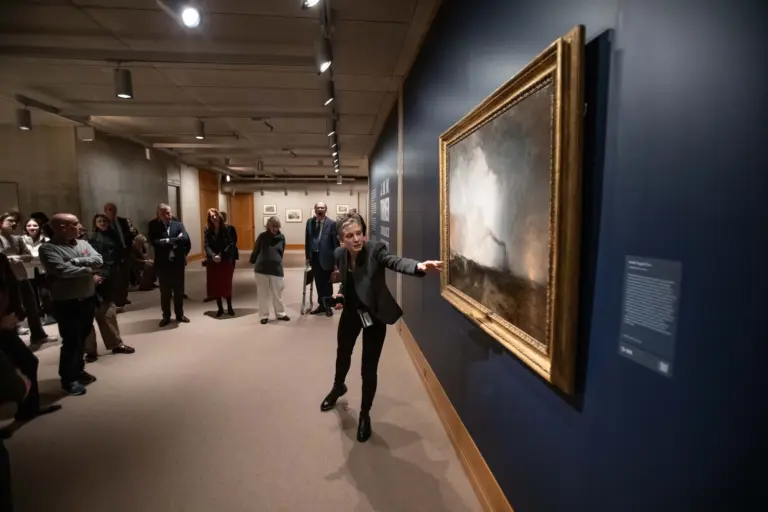
By Michael LaGamma
On July 26 David Alan Richards addressed the RMA on the subject of his new book “I Give These Books: The History of the Yale University Library, 1656-2022.”
Many university libraries, or those of their brethren William & Mary, Princeton, and Columbia, cannot be learned in any published comprehensive books.
The Harvard College library was of course the first template, since all of Yale’s first trustees but one had graduated from Harvard. But the always-smaller, always younger college library in Connecticut soon surpassed its rival in Cambridge in several respects. The Yale College Library was the first college library in this country:
• to possess copies of the works of Shakespeare and Milton, in 1714;
• to allow juniors, sophomores and freshmen to withdraw books, in 1727;
• the first to buy books, with funds from selling duplicates, in 1731;
• the first to allow undergraduates to enter the library, in 1740 (not permitted at Harvard until 1765);
• the first to allow student access to the stacks, also in 1740;
• the first to print a catalog for undergraduates that was classified by subject (and not alphabetic by volume size), in 1743―this also the first library catalog in America to be indexed;
• the first to have the first endowed book fund, in 1763;
• the first to send the college professors abroad to buy books, in 1805 and 1822;
• the first to mount a campaign among alumni for cash donations to the library, in 1818;
• the first to give its librarian his own office, in 1843; and
• the first to publish a periodical journal about a university library’s collections, the Yale University Library Gazette, in 1926.
Yale was lucky. It never in its history suffered a devastating fire, as William & Mary did in 1705, and as Harvard did in 1764. Nor did any Yale president suffer like Harvard’s John Kirkland in 1823, when student rioters lit bonfires in the Yard, and one disgruntled collegian even ransacked the Cambridge armory for shells and powder to blow up the library. But, as Richards discovered, with enough dogged research, gathering such facts is relatively easy. Designing a comprehensive, soup-to-nuts history of a library, when it’s never been done before, is hard.
Arguably, there are two aspects to a library, the exterior or patron-visible part, and the interior or patron-invisible part, each aspect itself having two parts. For the exterior, those elements are the origins of the collections, and the architecture of their housing. For the interior, they are the strategies of growth and the changing metaphors of use. The growth of a library is organic and at times irregular, but Richards believes this framing of the components will help explain the whole course of development.
The author noted two recent trends. The first is remote borrowing. With the Borrow Direct program begun in 1999, which―having begun with Yale, Columbia, and the University of Pennsylvania―now includes all the Ivy League schools, plus MIT, Duke, Johns Hopkins, the University of Chicago, and Stanford. Yale’s students and faculty have access to 90 million books.
The other trend is of course the shift to digital. In 2019, Yale University Library, spread over fifteen different library locations, was comprised of 14.4 million print books and 1.77 million electronic volumes, totaling about 15.8 million titles. Today its digital preservation system houses over one petabyte (one quadrillion bytes) of data, and over 16 million files―more than the number of printed books there.
David Alan Richards holds history degrees from Yale College and the University of Cambridge, where he was a Keasbey Scholar, and then attended Yale Law School. He is the recently-retired chair of the Yale Library Associates, the alumni support group for the university’s Beinecke Rare Book & Manuscript Library.
To see the full presentation, go to https://greenwichrma.org, cursor to “Speakers” and click on “Speaker Videos.”
The RMA’s upcoming presentation on August 9th will feature Dr. Timothy A. Brunner. Scheduled for 11AM on Wednesday August 9, Dr. Brunner will speak to the fabrication of computer circuits using extreme ultraviolet light (EUV).
The relentless advancement in processing power and miniaturization of computer chips has been made possible by the continuous improvement in lithography technology. Lithography is a complex process used to create microscopic circuit patterns on silicon wafers, which are essential components of modern devices like smartphones, tablets, and laptops.
The key to achieving finer and more intricate patterns lies in using shorter wavelength light. Initially, blue light was employed for lithography in the 1980s because of its relatively shorter wavelength compared to green or red light. As technology progressed, ultraviolet light was utilized in the 2000s. Presently, the most cutting-edge chips necessitate the use of “extreme” ultraviolet light (EUV).
However, generating EUV is an immensely challenging task. Not only is it difficult to produce, but it is also strongly absorbed by air and the glass used in the lenses to focus the light rays. Moreover, during the chip manufacturing process, multiple super fine patterns must be accurately overlaid on top of each other with exceptional precision; otherwise, the chip will not function properly.
The presentation highlights the significance of EUV lithography as the driving force behind high-volume chip manufacturing today. Despite sounding like science fiction, this technology has become essential to continue producing chips that are faster, more powerful, and cost-effective.
Dr. Timothy A. Brunner, an esteemed expert in the field with over 40 years of experience and numerous accolades, discusses the challenges and innovations related to EUV lithography, which has made it possible to create incredibly small and sophisticated patterns on silicon wafers at an astonishing speed of thousands of chips per minute.
The advancement of lithography and the usage of EUV have played a crucial role in shaping the current landscape of technology, enabling the production of highly capable and compact electronic devices that have become an integral part of modern life.
To stream the presentation at 11:00 AM on August 9th click on https://bit.ly/30IBj21 . this presentation will also be available on local public access TV channels, Verizon FIOS channel 24 and Optimum (Cablevision) channel 79.
Note: The views expressed in these presentations are those of the speakers They are not intended to represent the views of the RMA or its members. RMA speaker presentations are presented as a community service at no cost to in-person or Zoom attendees regardless of gender. The RMA urges all eligible individuals to become a member of our great organization, and thereby enjoy all of the available fellowship, volunteer, and community service opportunities which the RMA offers to its members. For further information, go to https://greenwichrma.org/ , or contact our membership chairman (mailto:members@greenwichrma.org).




